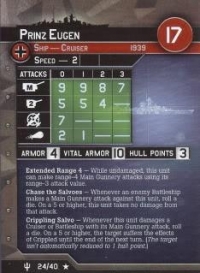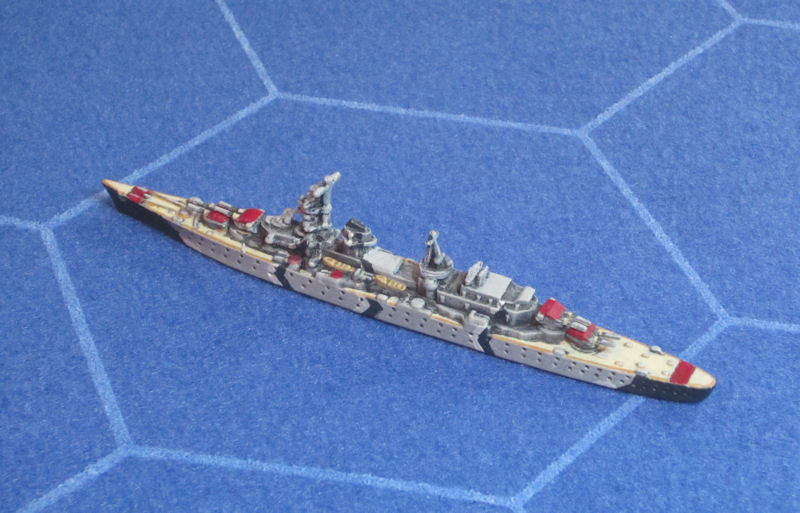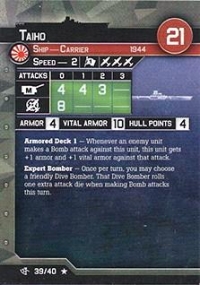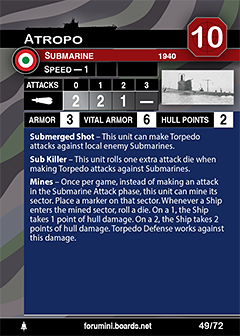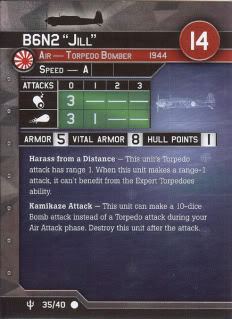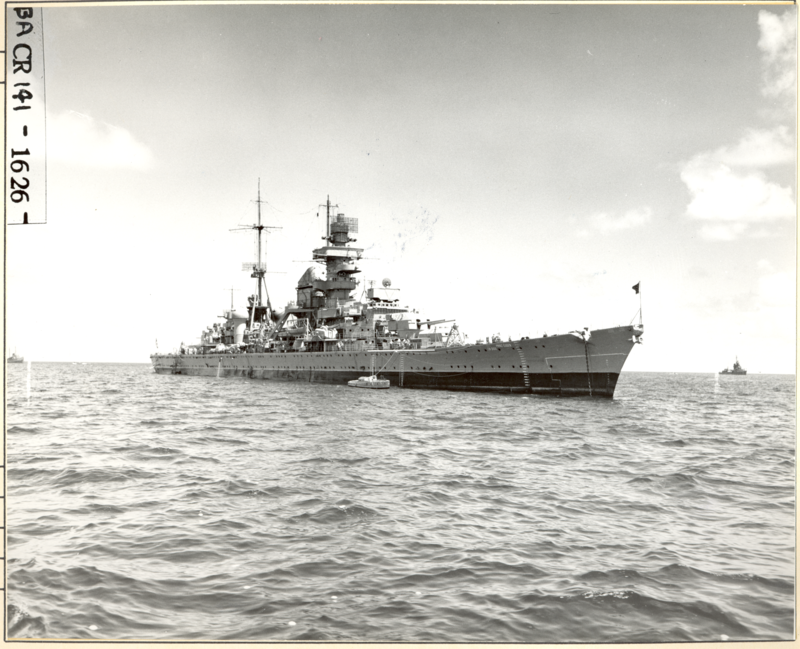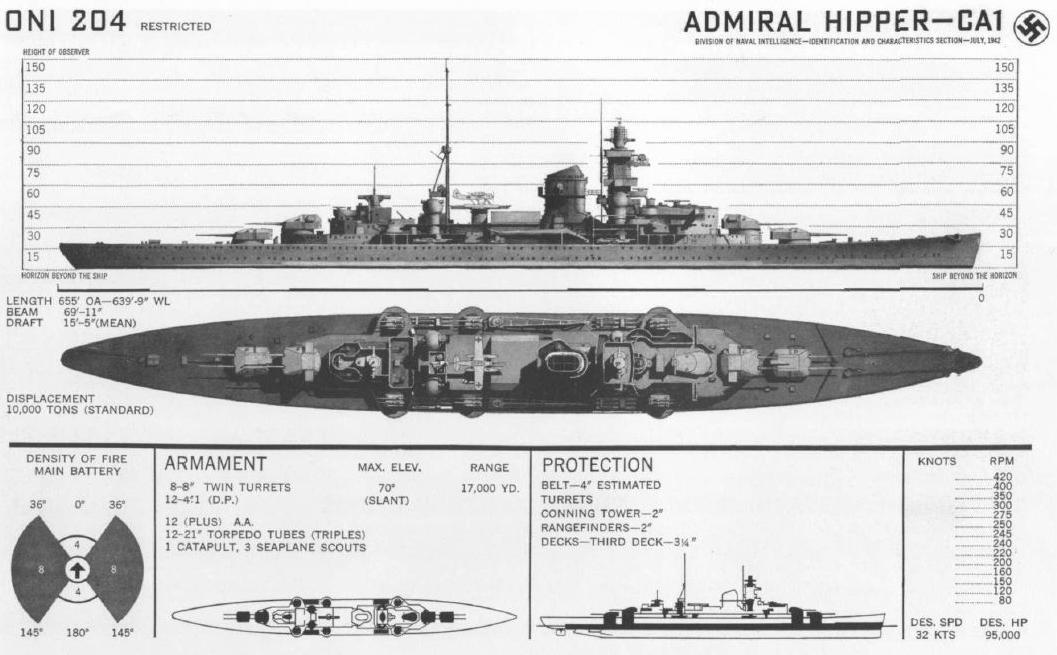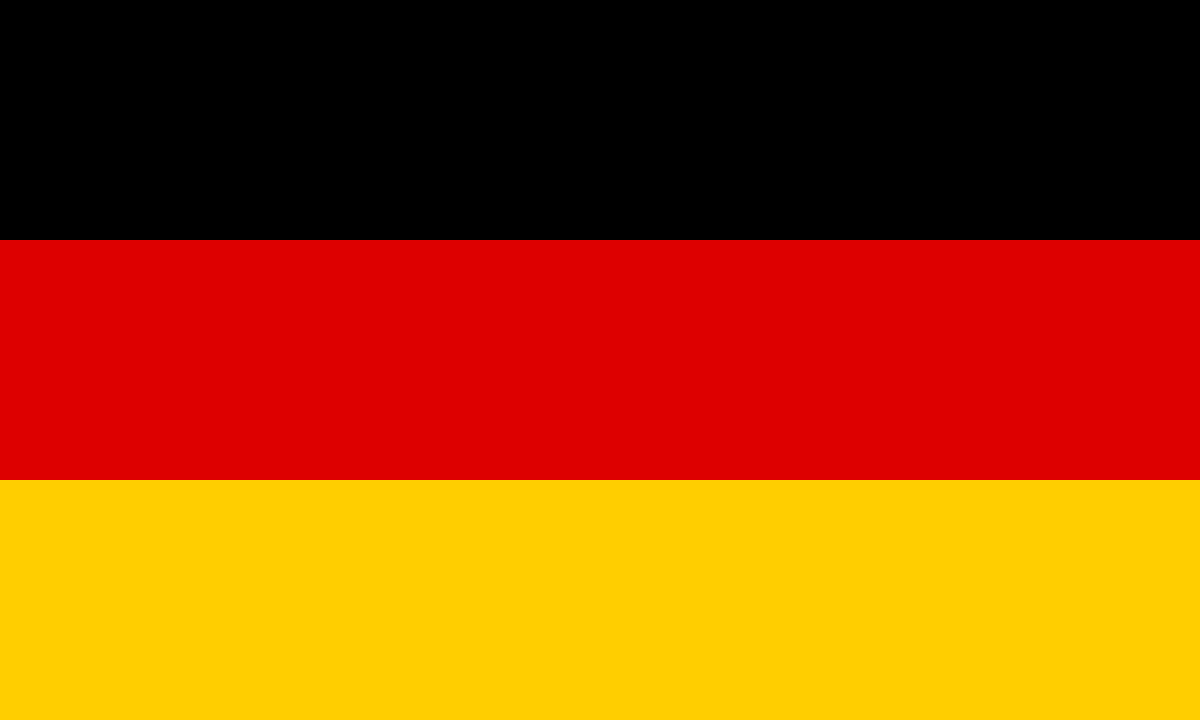Prinz Eugen
| General Type | Ship |
| Unit Type | Cruiser |
| Cost | 17 |
| Set | Flank Speed |
| Manufacturer | Hasbro |
| Available | 1939 |
| Set ID | 24 |
| Game Class Limits | Hipper |
| Country | Germany (Details) |
| Prototype | Prinz Eugen (Details) |
| Class | Admiral Hipper (Details) |
| Armor | 4 |
| Vital | 10 |
| Hull Points | 3 |
| Speed | 139 |
| Primary | 9/9/8/7 |
| Secondary | 5/5/4/0 |
| Torpedoes | 2/1/0/0 |
| AA | 7/0/-/- |
| Special Ability | Chase the Salvoes |
| Special Ability | Crippling Salvo |
| Special Ability | Extended Range 4 |
| Game Rarity | R |
Click to see the details
market
Click to see the details
history
Click to see the details
collector
Prototype:
Prinz Eugen (German pronunciation: [ˈpʁɪnts ɔʏˈɡeːn]) was an Admiral Hipper-class heavy cruiser, the third of a class of five vessels. She served with Nazi Germany's Kriegsmarine during World War II. The ship was laid down in April 1936, launched in August 1938, and entered service after the outbreak of war, in August 1940. She was named after Prince Eugene of Savoy, an 18th-century Austrian general. She was armed with a main battery of eight 20.3 cm (8.0 in) guns and, although nominally under the 10,000-long-ton (10,000 t) limit set by the Anglo-German Naval Agreement, actually displaced over 16,000 long tons (16,000 t).
Prinz Eugen saw action during Operation Rheinübung, an attempted breakout into the Atlantic Ocean with the battleship Bismarck in May 1941. The two ships destroyed the British battlecruiser Hood and moderately damaged the battleship Prince of Wales in the Battle of the Denmark Strait. Prinz Eugen was detached from Bismarck during the operation to raid Allied merchant shipping, but this was cut short due to engine troubles. After putting into occupied France and undergoing repairs, the ship participated in Operation Cerberus, a daring daylight dash through the English Channel back to Germany. In February 1942, Prinz Eugen was deployed to Norway, although her time stationed there was curtailed when she was torpedoed by the British submarine Trident days after arriving in Norwegian waters. The torpedo severely damaged the ship's stern, which necessitated repairs in Germany.
Upon returning to active service, the ship spent several months training officer cadets in the Baltic before serving as artillery support for the retreating German Army on the Eastern Front. After the German collapse in May 1945, she was surrendered to the British Royal Navy before being transferred to the US Navy as a war prize. After examining the ship in the United States, the US Navy assigned the cruiser to the Operation Crossroads nuclear tests at Bikini Atoll. Having survived the atomic blasts, Prinz Eugen was towed to Kwajalein Atoll, where she ultimately capsized and sank in December 1946. The wreck remains partially visible above the water approximately two miles northwest of Bucholz Army Airfield, on the edge of Enubuj. One of her screw propellers was salvaged and is on display at the Laboe Naval Memorial in Germany.
Prinz Eugen saw action during Operation Rheinübung, an attempted breakout into the Atlantic Ocean with the battleship Bismarck in May 1941. The two ships destroyed the British battlecruiser Hood and moderately damaged the battleship Prince of Wales in the Battle of the Denmark Strait. Prinz Eugen was detached from Bismarck during the operation to raid Allied merchant shipping, but this was cut short due to engine troubles. After putting into occupied France and undergoing repairs, the ship participated in Operation Cerberus, a daring daylight dash through the English Channel back to Germany. In February 1942, Prinz Eugen was deployed to Norway, although her time stationed there was curtailed when she was torpedoed by the British submarine Trident days after arriving in Norwegian waters. The torpedo severely damaged the ship's stern, which necessitated repairs in Germany.
Upon returning to active service, the ship spent several months training officer cadets in the Baltic before serving as artillery support for the retreating German Army on the Eastern Front. After the German collapse in May 1945, she was surrendered to the British Royal Navy before being transferred to the US Navy as a war prize. After examining the ship in the United States, the US Navy assigned the cruiser to the Operation Crossroads nuclear tests at Bikini Atoll. Having survived the atomic blasts, Prinz Eugen was towed to Kwajalein Atoll, where she ultimately capsized and sank in December 1946. The wreck remains partially visible above the water approximately two miles northwest of Bucholz Army Airfield, on the edge of Enubuj. One of her screw propellers was salvaged and is on display at the Laboe Naval Memorial in Germany.
Class History:
The Admiral Hipper-class was a group of five heavy cruisers built by Nazi Germany's Kriegsmarine in the mid-1930s. The class comprised Admiral Hipper, the lead ship, Blücher, Prinz Eugen, Seydlitz, and Lützow. Only the first three ships of the class were completed to see action during World War II. Work on Seydlitz stopped when she was approximately 95 percent complete; it was decided to convert her into an aircraft carrier, but this was not completed either. Lützow was sold incomplete to the Soviet Union in 1940.
Admiral Hipper and Blücher took part in Operation Weserübung, the invasion of Norway in April 1940. Blücher was sunk by Norwegian coastal defenses outside Oslo while Admiral Hipper led the attack on Trondheim. She then conducted sorties into the Atlantic to attack Allied merchant shipping. In 1942, she was deployed to northern Norway to attack shipping to the Soviet Union, culminating in the Battle of the Barents Sea in December 1942, where she was damaged by British cruisers. Prinz Eugen saw her first action during Operation Rheinübung with the battleship Bismarck. She eventually returned to Germany during the Channel Dash in 1942, after which she too went to Norway. After being torpedoed by a British submarine, she returned to Germany for repairs. Admiral Hipper while decommissioned after returning to Germany in early 1943, was partially repaired and recommissioned in the fall of 1944 for a refugee transport mission in 1945. Only Prinz Eugen continued to serve in full commission and stayed in the Baltic until the end of the war.
Admiral Hipper was scuttled in Kiel in May 1945, leaving Prinz Eugen as the only member of the class to survive the war. She was ceded to the US Navy, which ultimately expended the ship in the Operation Crossroads nuclear tests in 1946. Seydlitz was towed to Königsberg and scuttled before the advancing Soviet Army could seize the ship. She was ultimately raised and broken up for scrap. Lützow, renamed Petropavlovsk, remained unfinished when the Germans invaded the Soviet Union. The ship provided artillery support against advancing German forces until she was sunk in September 1941. She was raised a year later and repaired enough to participate in the campaign to relieve the Siege of Leningrad in 1944. She served on in secondary roles until the 1950s, when she was broken up
Admiral Hipper and Blücher took part in Operation Weserübung, the invasion of Norway in April 1940. Blücher was sunk by Norwegian coastal defenses outside Oslo while Admiral Hipper led the attack on Trondheim. She then conducted sorties into the Atlantic to attack Allied merchant shipping. In 1942, she was deployed to northern Norway to attack shipping to the Soviet Union, culminating in the Battle of the Barents Sea in December 1942, where she was damaged by British cruisers. Prinz Eugen saw her first action during Operation Rheinübung with the battleship Bismarck. She eventually returned to Germany during the Channel Dash in 1942, after which she too went to Norway. After being torpedoed by a British submarine, she returned to Germany for repairs. Admiral Hipper while decommissioned after returning to Germany in early 1943, was partially repaired and recommissioned in the fall of 1944 for a refugee transport mission in 1945. Only Prinz Eugen continued to serve in full commission and stayed in the Baltic until the end of the war.
Admiral Hipper was scuttled in Kiel in May 1945, leaving Prinz Eugen as the only member of the class to survive the war. She was ceded to the US Navy, which ultimately expended the ship in the Operation Crossroads nuclear tests in 1946. Seydlitz was towed to Königsberg and scuttled before the advancing Soviet Army could seize the ship. She was ultimately raised and broken up for scrap. Lützow, renamed Petropavlovsk, remained unfinished when the Germans invaded the Soviet Union. The ship provided artillery support against advancing German forces until she was sunk in September 1941. She was raised a year later and repaired enough to participate in the campaign to relieve the Siege of Leningrad in 1944. She served on in secondary roles until the 1950s, when she was broken up
Country:
Germany is a Western European country with a landscape of forests, rivers, mountain ranges and North Sea beaches. It has over 2 millennia of history. Berlin, its capital, is home to art and nightlife scenes, the Brandenburg Gate and many sites relating to WWII. Munich is known for its Oktoberfest and beer halls, including the 16th-century Hofbräuhaus. Frankfurt, with its skyscrapers, houses the European Central Bank.
Item created by: Lethe
on 2015-05-31 17:46:30
Last edited by: gdm on 2019-08-30 11:52:08
If you see errors or missing data in this entry, please feel free to log in and edit it. Anyone with a Gmail account can log in instantly.
Last edited by: gdm on 2019-08-30 11:52:08
If you see errors or missing data in this entry, please feel free to log in and edit it. Anyone with a Gmail account can log in instantly.


